The Five Ways The Universe Might End
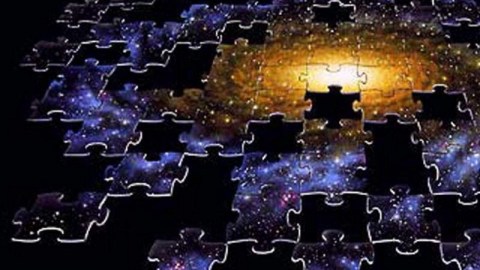
Everything we know can be traced back to the Big Bang, and before that, cosmic inflation. But what if we look to the future?
Looking out at the Universe today, it’s easy to be absolutely awed by all that we can find. The stars in our night sky are just a tiny fraction — a few thousand out of hundreds of billions — of what’s present in our Milky Way. The Milky Way itself is just one lonesome galaxy out of trillions present within the observable Universe, which extends in all directions for some 46 billion light-years.
And it all began some 13.8 billion years ago from a hot, dense, rapidly expanding state known as the Big Bang. That’s the first moment in which we can describe our Universe as being full of matter-and-radiation, and stepping forward from that state given the known laws of physics enables us to explain how the cosmos took its modern shape. But it’s all still expanding, forming new stars, and evolving. How will it end? Here’s what science has to say.
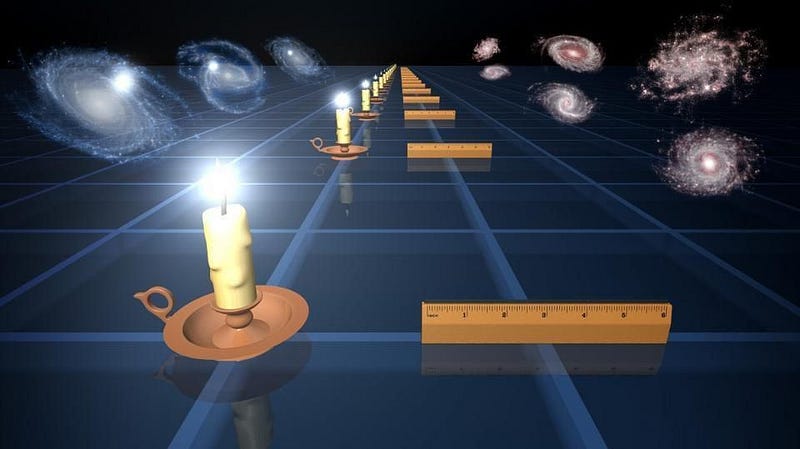
For a long time, scientists who studied the structure and evolution of the Universe considered three possibilities, based in the simple physics of General Relativity and the context of the expanding Universe. On the one hand, gravitation works to pull everything together; it’s an attractive force governed by the matter and energy, in all their forms, present in the Universe. On the other hand, there’s the initial expansion rate, working to drive everything apart.
The Big Bang marks the starting gun of the greatest race of all time: between gravity and the expansion rate. Which one will eventually win in our Universe? The answer to that question, the classical reasoning went, should determine our Universe’s fate.
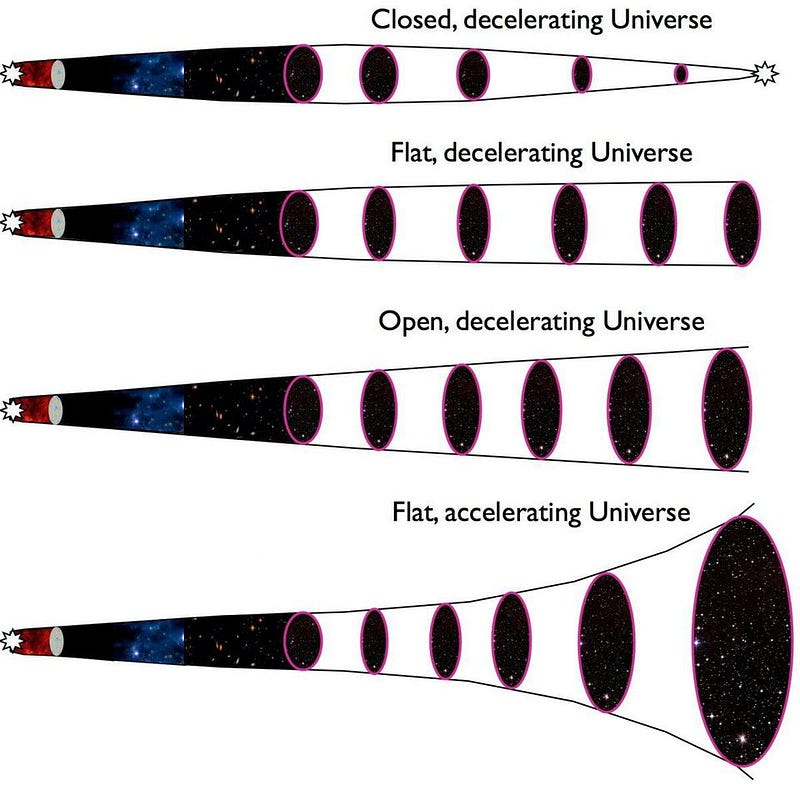
Here’s what we thought the possibilities were:
- The Universe recollapses in a Big Crunch. The expansion starts out rapidly, and the large amount of matter and radiation work to pull everything back together. If there’s more than enough matter-and-energy, the Universe will expand to some maximum size, the expansion will reverse to contraction, and the Universe will recollapse.
- The Universe expands forever, resulting in a Big Freeze. Everything starts out the same as above, only this time, the amount of matter-and-energy is insufficient to counteract the expansion. The Universe keeps expanding forever, as the expansion rate keeps dropping but never reaches zero.
- The Universe’s expansion asymptotes to zero. Imagine the borderline situation right between the above two examples. If there were one more proton, we’d recollapse; one fewer, and we’d expand forever. In this critical (or Goldilocks) case, the Universe expands forever, but at the slowest rate possible.
To know which one was correct, all we had to do was measure how fast the Universe was expanding, and how that expansion rate changed over time. Physics would determine the rest.
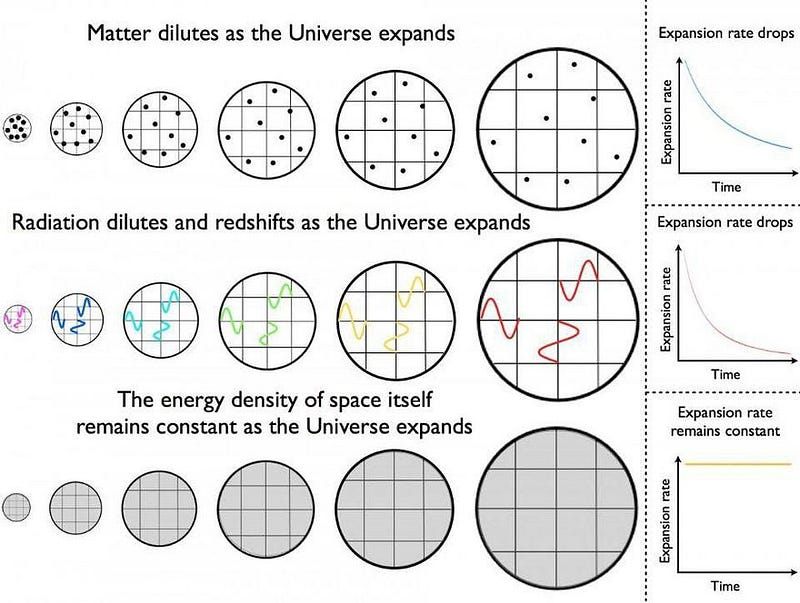
It was one of the great quests of modern astrophysics. Measure the rate at which the Universe was expanding, and you know how the fabric of space is changing today. Measure how the expansion rate has changed over time, and you know how the fabric of space changed in the past.
Put those two pieces of information together, and the way the expansion rate both is and also has changed allows you to determine what the Universe is made out of, and in what ratios.
To the best of our knowledge, informed by these measurements, we’ve determined that the Universe is made of about 0.01% radiation, 0.1% neutrinos, 4.9% normal matter, 27% dark matter, and 68% dark energy. This quest, which began as early as the 1920s for some, got an unexpected answer in the late 1990s.
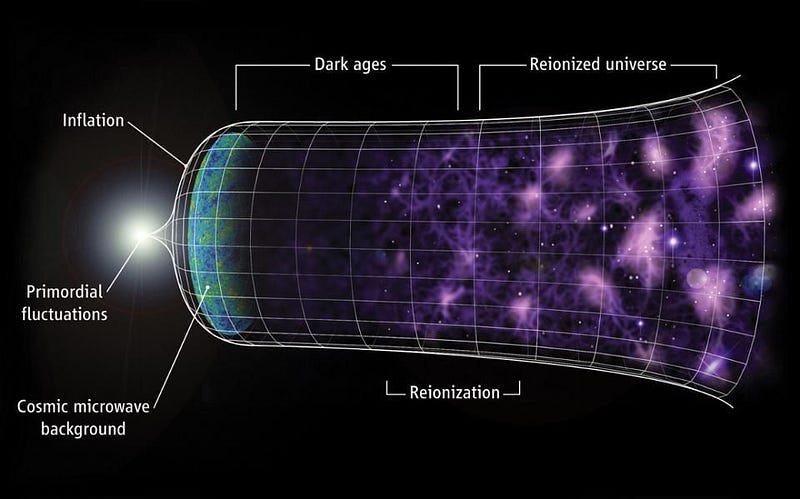
So if dark energy dominates the expansion of the Universe, what does that mean for our fate? It all depends on how — or if — dark energy evolves with time. Here are the five possibilities.
1.) Dark energy is an expansion-dominating cosmological constant. This is the default option given the best data we have today. While matter becomes less dense as the Universe expands, diluting as the volume expands, dark energy represents a non-zero amount of energy inherent to the fabric of space itself. As the Universe expands, the dark energy density remains constant, causing the expansion rate to asymptote not to zero, but a positive value.
This leads to an exponentially-expanding Universe, and will eventually push away everything that isn’t part of our local group. Already, 97% of the visible Universe is unreachable under these conditions.
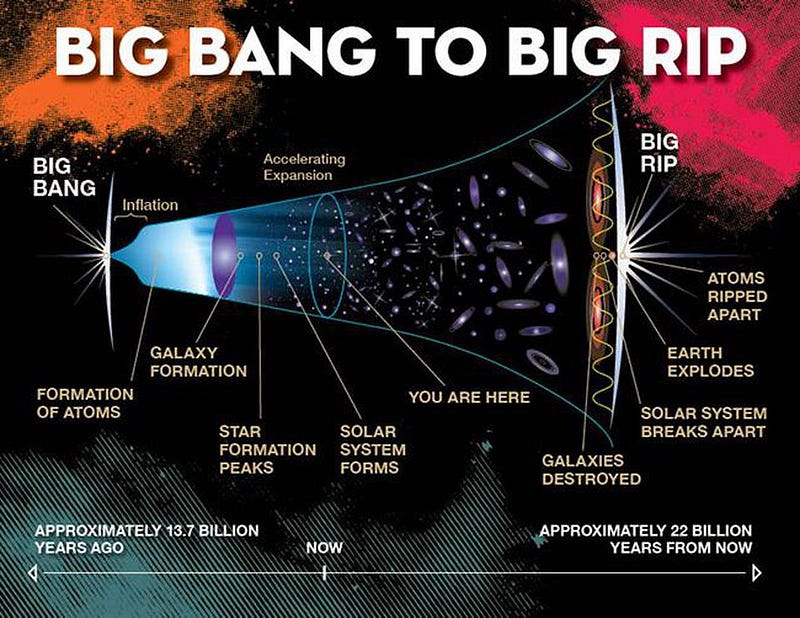
2.) Dark energy is dynamical, and grows more powerful over time. Dark energy appears to be a new form of energy that’s inherent to space itself, implying that it has a constant energy density. But it could also be changing over time. One possible way it could be changing is that it could be strengthening in magnitude, which would cause the Universe’s expansion rate to speed up over time.
Not only would more distant objects appear to accelerate away from us, they’d do so at an increasing rate. Even worse, objects that are now gravitationally bound today — like galaxy clusters, individual galaxies, solar system, and even atoms — would all someday become unbound as dark energy strengthened. In the final moments of the Universe, subatomic particles and the fabric of space itself would get torn apart. This “Big Rip” fate is a second possibility.
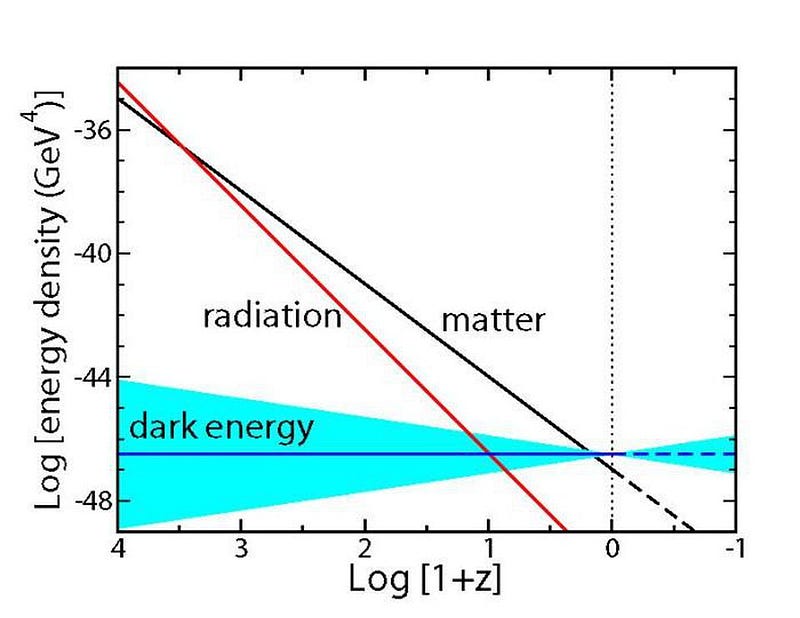
3.) Dark energy is dynamical, and decays over time. How else could dark energy change? Instead of strengthening, it could weaken. Sure, the expansion rate is consistent with a constant amount of energy belonging to space itself, but this energy density could be dropping, too.
If it decays away to zero, it could lead to one of the original possibilities expressed above: the Big Freeze. The Universe would still expand, but without enough matter and other forms of energy to recollapse.
If it decays away to become negative, however, it could lead to another of the possibilities: a Big Crunch. The Universe could be filled with energy intrinsic to space that suddenly switched signs and caused space to recollapse. While the timescale for these changes is constrained to be far longer than the time since the Big Bang, it could still occur.
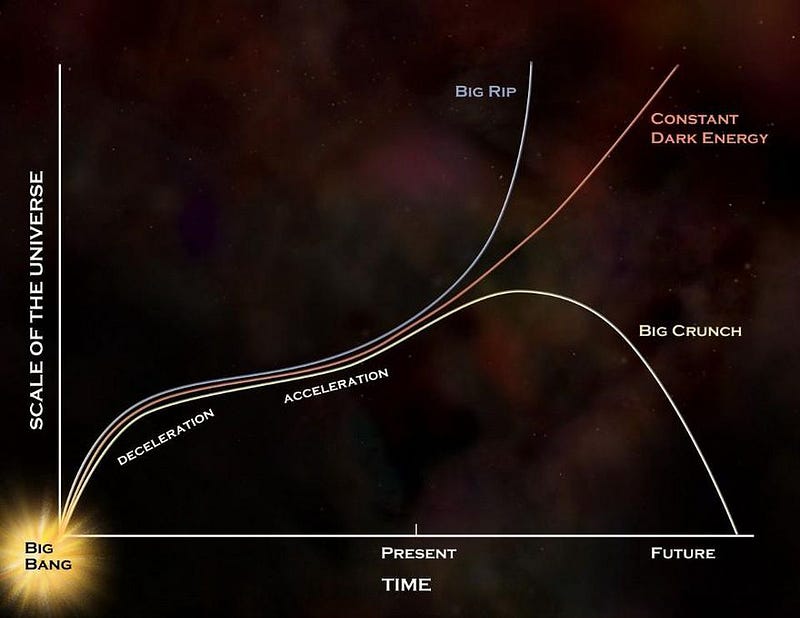
4.) Dark energy could transition into another form of energy, rejuvenating the Universe. If dark energy doesn’t decay, but instead remains constant or even strengthens, there’s another possibility that arises. This energy, inherent to the fabric of space today, may not remain in that form forever. Instead, it could get converted into matter-and-radiation, similar to what occurred when cosmic inflation ended and the hot Big Bang began.
If dark energy remains constant until that point, it will create a very, very cold and diffuse version of the hot Big Bang, where only neutrinos and photons can self-create. But if dark energy increases in strength, it could lead to an inflation-like state followed by a new, truly hot Big Bang once again. This is the most straightforward way to rejuvenate the Universe, and create a cyclic-like set of parameters, where the newly-created Universe gets another chance to behave just like ours did.
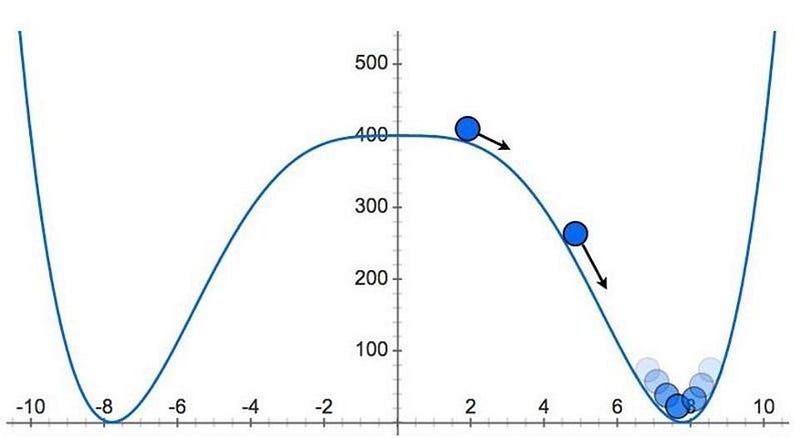
5.) Dark energy is related to the zero-point energy of the quantum vacuum, and will decay, destroying the Universe we know. This is the most destructive possibility of all. What if dark energy isn’t the true value of empty space in the lowest-energy configuration, but is the result of symmetries early on in the Universe having broken into a false-minimum configuration?
If so, there would be a way for it to quantum-tunnel into a lower-energy state, changing the laws of physics and destroying all the bound states (i.e., particles) of quantum fields today. If the quantum vacuum is unstable in this particular way, wherever this decay occurs will result in the destruction of everything in the Universe in a bubble which expands outward at the speed of light. If such a signal ever reached us, it would be accompanied by our instantaneous destruction, too.
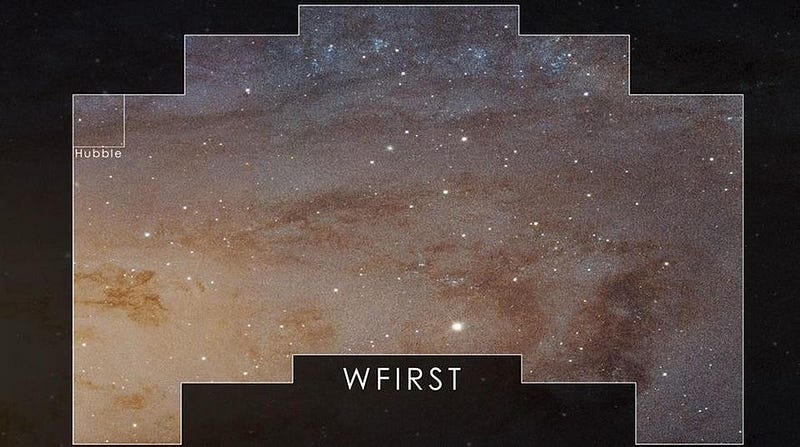
Although we do not know which of these possibilities is true for our Universe, the data is incredibly consistent with the first option: of dark energy truly being a constant. Right now, our observations of how the Universe has evolved — particularly due to the cosmic microwave background radiation and the large-scale structure of the Universe — place tight constraints on how much wiggle-room there is for dark energy to change.
With the coming advent of NASA’s flagship astrophysics mission of the 2020s, WFIRST, we’re poised to tighten up that wiggle-room by perhaps another factor of 10 or so. If dark energy offers any indications that our fate will be different from the one we anticipate today, that observatory will be the one with the best chance to scientifically reveal this new truth about our Universe. Until then, all we have are the possibilities we know to consider. The rest is up to science.
Ethan Siegel is the author of Beyond the Galaxy and Treknology. You can pre-order his third book, currently in development: the Encyclopaedia Cosmologica.





